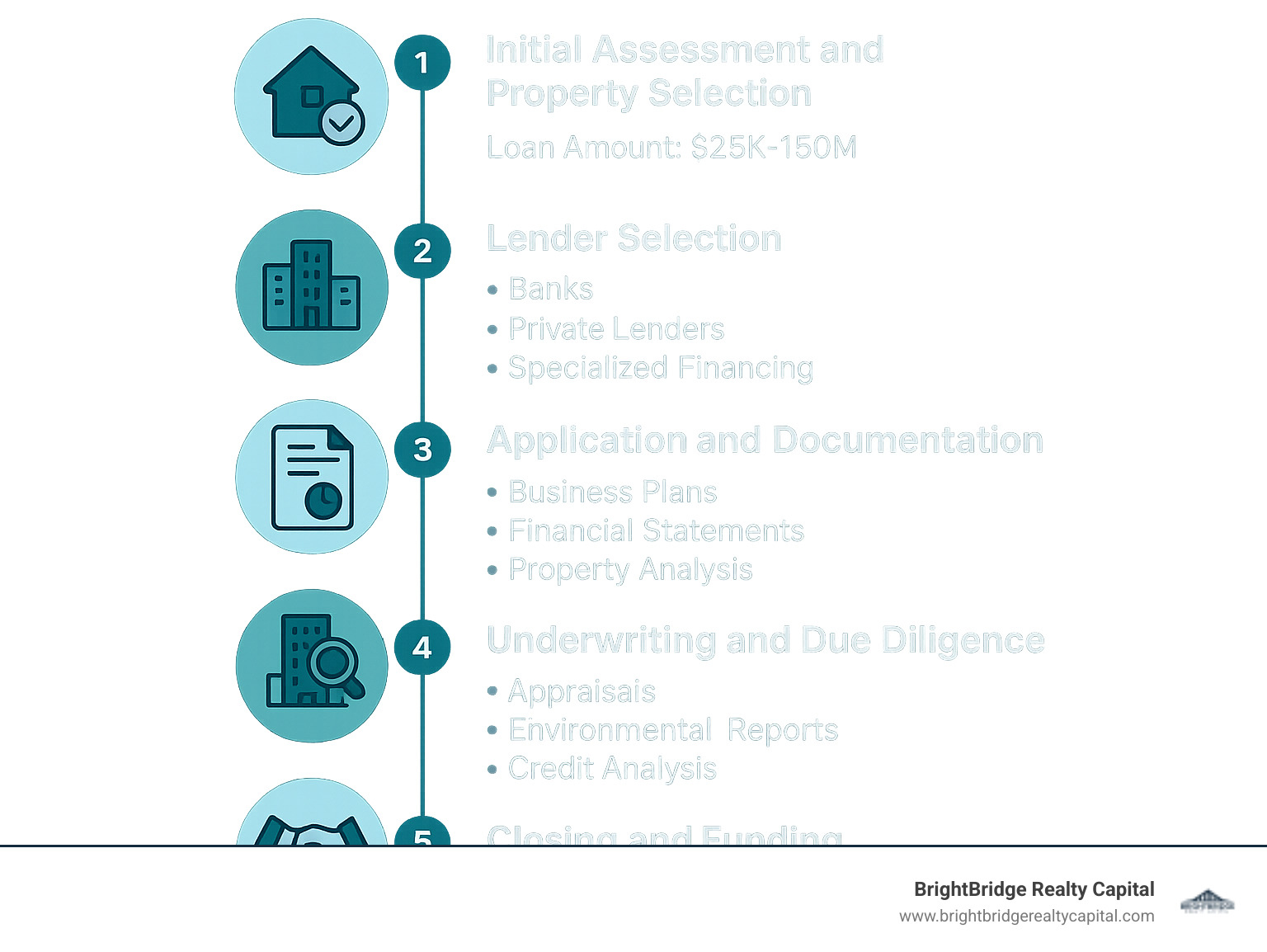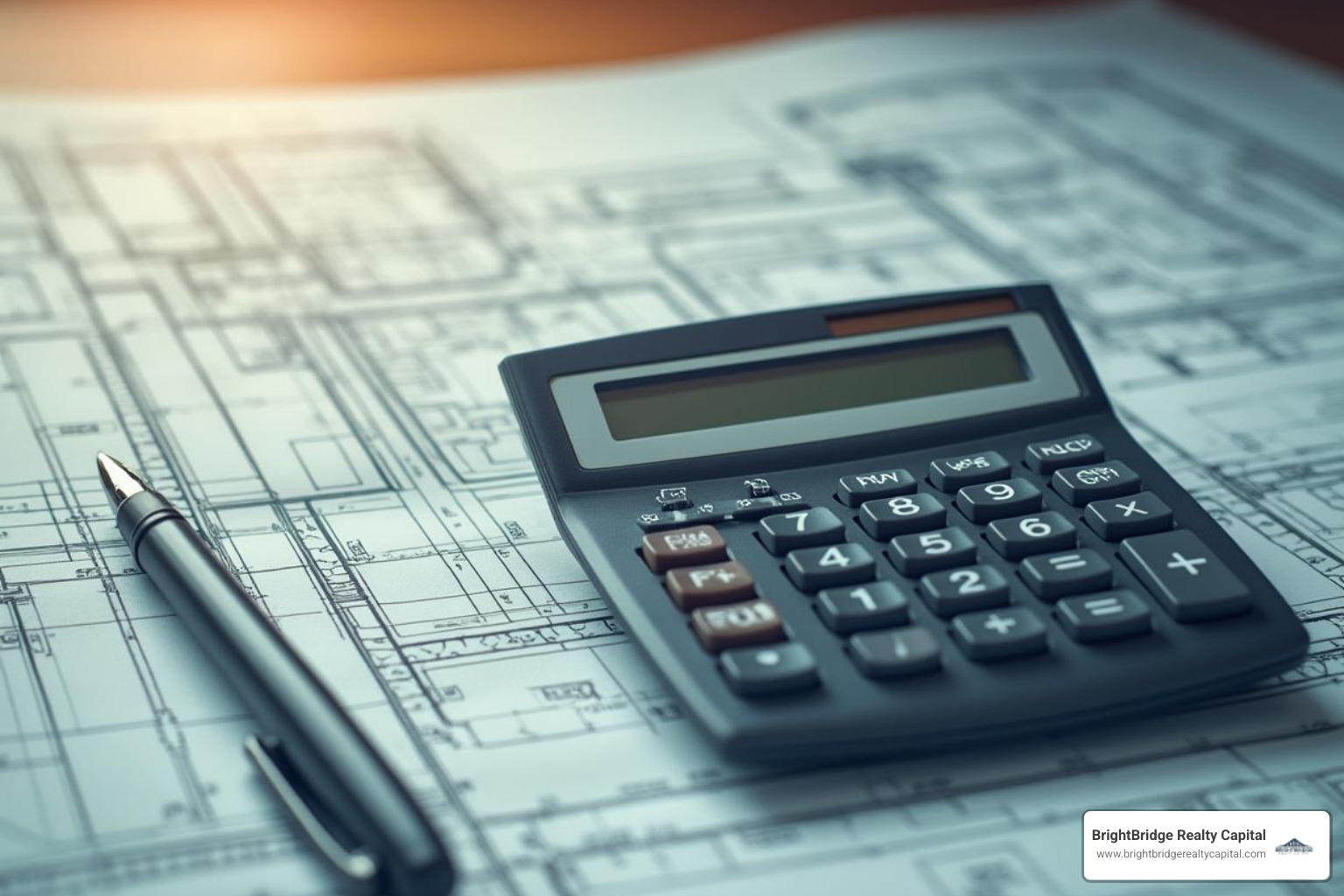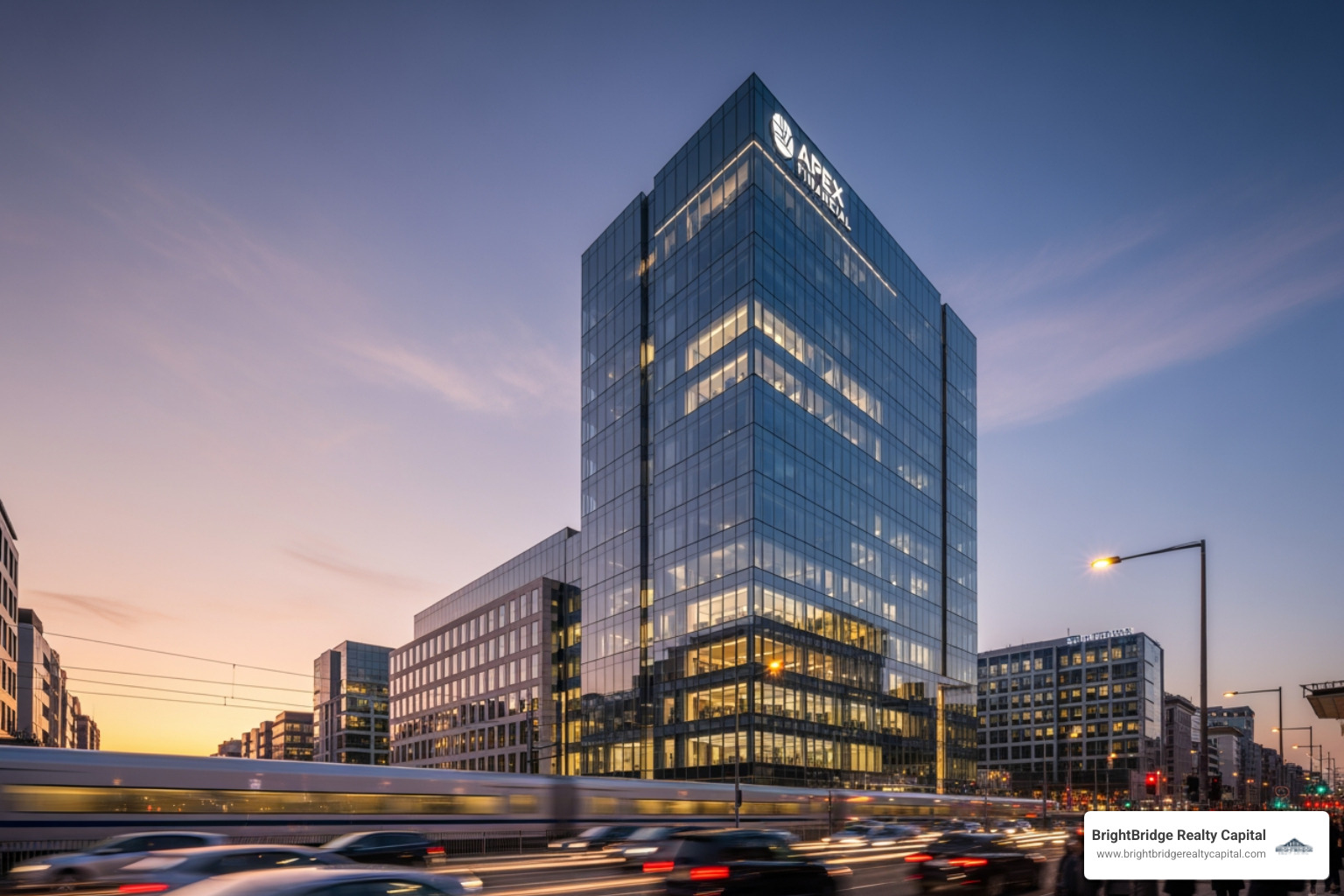Real Estate Capital Made Easy: Financing Your Commercial Property Dreams

Why Commercial Real Estate Financing Opens Investment Opportunities
Commercial real estate financing is the fundamental catalyst that transforms ambitious investment blueprints into tangible, income-producing assets. From sprawling apartment complexes and busy retail centers to essential industrial warehouses, financing is the key that open ups the door to these lucrative opportunities. For both new and seasoned investors, a deep understanding of the available financing options isn't just a preliminary step—it's the cornerstone of building a resilient and profitable property portfolio and achieving long-term wealth.
At its core, commercial real estate financing is about leverage—the strategic use of borrowed capital to increase the potential return of an investment. By using a loan to cover a significant portion of the purchase price (often 60-80%), investors can acquire much larger and more valuable assets than they could with cash alone. This amplification of buying power not only opens up a wider range of properties but also allows for portfolio diversification. Instead of concentrating all capital into one property, an investor can use financing to acquire multiple assets across different property types or geographic locations, spreading risk and creating multiple streams of income.
A Glimpse at Your Financing Toolkit
Navigating commercial real estate financing means choosing the right instrument for your specific strategy. Here’s a quick overview:
- Conventional Loans: The workhorse of the industry. With 5-20 year terms and requiring 20-30% down, these are best for stabilized, cash-flowing properties with strong fundamentals.
- SBA Loans: A powerful government-backed option offering up to 90% financing with long 10-25 year terms, exclusively for businesses purchasing their own owner-occupied properties.
- Bridge Loans: The sprinter's choice. These short-term loans (6 months-3 years) close fast, making them ideal for value-add projects, repositioning assets, or seizing time-sensitive opportunities.
- Hard Money Loans: The flexible problem-solver. With terms of 1-3 years and down payments of 25-40%, these asset-based loans are perfect for investors with poor credit, distressed properties, or unconventional deals where speed is paramount.
- Construction Loans: The builder's foundation. This financing is specifically designed for ground-up development and major renovations, with funds disbursed in stages as the project progresses.
The commercial financing landscape is vast, with loan amounts ranging from $25,000 for smaller projects to well over $150 million for institutional-grade assets. Interest rates and terms are not one-size-fits-all; they fluctuate based on the loan type, property quality, market conditions, and borrower strength. Lenders universally scrutinize key metrics like the Debt Service Coverage Ratio (DSCR), typically requiring a minimum of 1.25:1, and Loan-to-Value (LTV) ratios, which generally fall between 60-75%.
Getting the right financing isn't just about finding the lowest rate—it's about forging a strategic partnership and aligning the loan's structure with your investment's unique business plan and timeline.
Consider the story of one of our clients, an investor who found a prime mixed-use building but was stonewalled by their traditional bank. "We were about 10 days away from our purchase contract expiring and losing a building we knew had incredible potential. The bank's process was just too slow. I was ready to give up, but our new lender, a specialized financing partner, stepped in. They understood the urgency and the value-add plan. They assured us they could close in the time remaining... and they did, with three days to spare." This scenario highlights a critical truth: the right financing partner does more than provide capital; they provide solutions, speed, and certainty.
I'm Daniel Lopez, a loan officer at BrightBridge Realty Capital. My career has been dedicated to helping investors steer the complexities of commercial real estate financing, from quick fix-and-flip projects to the acquisition of large, stabilized portfolios. My experience has consistently shown that a knowledgeable and agile financing partner is the element that transforms challenging deals into highly profitable investments, especially when market conditions demand speed and flexibility.

Commercial real estate financing further reading:
Understanding the Landscape of Commercial Real Estate Financing

Commercial real estate financing refers to the wide array of debt instruments used to purchase, develop, or refinance properties that are intended for business operations or to generate income. It is the financial engine that powers the entire commercial property ecosystem, providing the essential capital needed to acquire a new office building, develop a modern retail center, or refinance an existing apartment complex to improve cash flow and fund renovations.
The spectrum of properties you can finance is incredibly broad, with each category presenting its own unique investment characteristics, risk profiles, and income potential.
Here is a more detailed look at common commercial property types eligible for financing:
- Multifamily Properties: This popular asset class includes everything from duplexes to large apartment complexes, student housing, and senior living facilities. Lenders often favor multifamily due to its consistent demand and multiple income streams (tenants), making it one of the most liquid commercial asset types.
- Office Buildings: These range from single-tenant suburban spaces to towering multi-tenant skyscrapers in central business districts and specialized medical office buildings (MOBs). Financing often depends on tenant quality, lease terms, and building class (A, B, or C).
- Retail Centers: This category includes neighborhood strip malls, large power centers anchored by national tenants, and single-tenant retail stores (e.g., a standalone pharmacy or fast-food restaurant). Lenders closely examine tenant mix, sales performance, and the threat of e-commerce.
- Industrial Warehouses: A booming sector, this includes massive distribution centers, manufacturing facilities, and smaller light industrial or flex spaces. The rise of logistics and e-commerce has made this a highly sought-after asset class for lenders.
- Self-Storage Facilities: Known for their operational simplicity and recession-resilience, self-storage facilities are a favorite among investors seeking steady, predictable income.
- Hospitality Assets: This includes hotels, motels, and resorts. Financing for hospitality is highly specialized and sensitive to economic cycles, travel trends, and brand performance (e.g., Marriott, Hilton).
- Mixed-Use Properties: These dynamic buildings combine multiple uses, such as ground-floor retail with residential apartments or offices above. They offer diversified income but can be more complex to underwrite.
- Special Use Properties: This is a catch-all for unique assets like churches, car washes, gas stations, funeral homes, and mobile home parks. Financing often requires a specialized lender with experience in that specific niche.
- Raw Land: Financing raw land is challenging as it generates no income. Loans are typically short-term, have lower LTVs, and are provided to experienced developers with a clear and viable plan for a construction project.
Who Provides Commercial Real Estate Loans?
The world of commercial real estate financing is populated by a diverse cast of lenders, each with its own strengths, weaknesses, and target market. Knowing the players is crucial for finding the best partner for your project.
- Traditional Banks & Credit Unions: Often the first stop for investors, especially those with existing banking relationships. They offer competitive rates on stable, low-risk properties. Pros: Good rates, established relationships. Cons: Slow processing times (30-90 days), conservative underwriting, often require personal guarantees (recourse), and are less likely to fund value-add or transitional projects.
- Life Insurance Companies: These institutions are a major source of long-term, fixed-rate capital for high-quality, stabilized properties (Class A). They seek low-risk investments and offer some of the best rates and terms (7 to 25 years) for premium assets. Pros: Excellent rates, long-term fixed debt. Cons: Highly selective, only for top-tier properties and borrowers, slow to close.
- Private Lenders & Debt Funds: This rapidly growing sector fills the gaps left by traditional banks. They specialize in financing value-add projects, transitional properties, or complex situations that banks avoid. Pros: Speed, flexibility, creative structuring, focus on asset value over borrower credit. Cons: Higher interest rates and fees compared to banks.
- CMBS (Conduit) Lenders: Commercial Mortgage-Backed Securities lenders originate loans, pool them together with other similar loans, and then sell them as bonds to investors on the secondary market. These loans are typically non-recourse. Pros: Non-recourse, higher leverage possible. Cons: Inflexible servicing (you deal with a master servicer, not the original lender), rigid prepayment penalties (defeasance or yield maintenance).
- Institutional Investors: Large investment firms, pension funds, and wealth management groups may lend directly on large-scale projects or participate through joint ventures, providing both debt and equity.
Key Metrics Lenders Use for Evaluation
When underwriting a commercial real estate financing application, lenders perform a deep dive into both the property's financial viability and the borrower's strength. Unlike a home loan, the property's ability to generate sufficient income is the primary consideration.
- Loan-to-Value (LTV): This ratio compares the loan amount to the property's appraised value. It is calculated as
Loan Amount / Appraised Value. Commercial LTVs are typically 60% to 75%. For example, on a $1 million property, a 75% LTV loan would be $750,000. Lenders use the lesser of the purchase price or the appraised value for this calculation. - Debt Service Coverage Ratio (DSCR): This is arguably the most critical metric. It measures the property's ability to cover its mortgage payments from its own income. It's calculated by dividing the Net Operating Income (NOI) by the total annual debt service (principal + interest payments). A DSCR of 1.25:1 means the property generates $1.25 in income for every $1.00 of debt. Lenders almost always require a DSCR of 1.25:1 or higher.
- Borrower's Credit & Financial Health: While the property is paramount, lenders still assess the sponsor (borrower). They look for industry experience, a strong personal financial statement showing liquidity (cash reserves), and a good credit history as indicators of sound management and the ability to weather unexpected challenges.
- Net Operating Income (NOI): This is the property's gross potential income minus vacancy and all operating expenses (like property taxes, insurance, maintenance, management fees, utilities). It is calculated before accounting for mortgage payments or depreciation. A clear and well-supported NOI is the foundation of a loan application.
Understanding Key Loan Terms and Features
Commercial real estate financing has its own lexicon. Understanding these terms is vital.
- Loan Amounts: Can range from $25,000 to over $150 million, depending on the project's scale.
- Interest Rates: Can be Fixed (the rate remains the same for the loan term) or Floating (the rate adjusts periodically based on an index like the Secured Overnight Financing Rate (SOFR)). You can learn more about Floating (SOFR-based) rates here.
- Amortization Period: The total time it would take to fully pay off the loan if all payments are made, typically 25 to 30 years for commercial loans. This determines the size of the monthly payment.
- Loan Term: The actual length of time until the loan is due and must be repaid or refinanced. It is often shorter than the amortization period, ranging from 5 to 20 years.
- Balloon Payments: When the loan term is shorter than the amortization period, a large, lump-sum payment (the remaining principal balance) is due at the end of the term. For example, a loan with a 30-year amortization and a 10-year term will have a large balloon payment at the end of year 10.
- Prepayment Penalties: Fees charged for paying off a loan early. These can be significant and come in several forms, such as yield maintenance or defeasance, and are designed to protect the lender's expected return.
- Recourse vs. Non-Recourse: A recourse loan means the borrower is personally liable for the debt. If the property is foreclosed on and sold for less than the outstanding loan balance, the lender can pursue the borrower's other personal assets. A non-recourse loan limits the lender's collateral to the property itself, protecting the borrower's other assets. Non-recourse loans are highly desirable but are typically reserved for high-quality, stabilized assets and may have stricter terms.
Exploring Your Commercial Real Estate Loan Options
Choosing the right commercial real estate financing option is a critical strategic decision, akin to an architect selecting the right materials for a skyscraper. The optimal loan is not a one-size-fits-all solution; it depends entirely on your specific project, your financial standing, your timeline, and your ultimate investment goals.
Here's a detailed comparison of common loan types:
| Loan Type | Typical LTV | Term | Interest Rate (Typical Range) | Best For |
|---|---|---|---|---|
| Conventional | 60-75% | 5-20 years | 6-10% | Stabilized properties with strong cash flow, long-term holds, borrowers with excellent credit and experience. |
| SBA (504 & 7a) | Up to 90% | 10-25 years | 5-7% (variable/fixed) | Small businesses purchasing owner-occupied real estate (must occupy 51%+ of the space). Low down payment needs. |
| Bridge | 65-80% | 6 months-3 years | 8-12% | Value-add projects, quick acquisitions, property repositioning, lease-up periods, and situations requiring a fast close. |
| Hard Money | 50-75% | 1-3 years | 10-18% | Distressed properties, fix-and-flip projects, borrowers with credit challenges, land acquisition, or when speed is the absolute top priority. |

Long-Term and Permanent Financing
When your strategy involves acquiring a stable, income-generating property for a long-term hold, these financing options provide the stability and competitive rates you need.
Conventional loans are the bedrock of commercial financing, offered by banks, credit unions, and other traditional institutions. They are designed for properties with a proven track record of steady income and high occupancy. Borrowers are expected to have strong financials, good credit, and a solid down payment of 20-30%. In return, they receive competitive rates, terms from 5 to 20 years, and amortization schedules of 25 to 30 years. These are ideal for purchasing or refinancing a turnkey, stabilized asset.
SBA Loans, backed by the U.S. Small Business Administration, are a game-changer for small businesses looking to own their real estate. The key requirement is that the business must be "owner-occupied," meaning it will operate out of at least 51% of the property's leasable space. The two main types are:
- SBA 7(a) Loans: The most common type, with funds usable for a variety of business purposes, including real estate. Loan amounts go up to $5 million.
- SBA 504 Loans: Specifically for fixed assets like real estate and equipment. They feature a unique structure with up to 40% of the loan from a Certified Development Company (CDC) at a below-market rate, 50% from a traditional lender, and as little as 10% down from the borrower. These can finance projects up to $20 million or more.
Short-Term and Transitional Financing
When a property is not yet stabilized or when you need to move with lightning speed, short-term solutions are indispensable.
Bridge loans are aptly named, as they "bridge" a financial gap. These short-term loans (typically 6 months to 3 years) are perfect for value-add projects. For example, an investor might use a bridge loan to purchase a partially vacant office building, fund light renovations, and cover operating costs during the lease-up period. Once the property is stabilized with new tenants and increased income, the investor can refinance into a cheaper, long-term conventional loan. Bridge loans close much faster than conventional loans, making them essential for time-sensitive acquisitions. We offer competitive bridge programs up to five years, even for vacant properties.
Hard money loans are asset-based loans provided by private investors or specialized funds. The primary underwriting focus is the property's intrinsic value (the "hard" asset), not the borrower's credit score. This makes them an excellent tool for distressed properties, fix-and-flip projects, or situations where a borrower has credit issues or unverifiable income. While interest rates are higher and down payments larger (25-40%), the key advantages are unparalleled speed and flexibility. A hard money loan can often be funded in as little as 7-10 business days, a timeline traditional lenders simply cannot match.
Specialized Commercial Real Estate Financing
Beyond the common loan types, a world of specialized solutions exists for unique projects and sophisticated investment strategies.
Construction loans are designed for building from the ground up (ground-up development) or undertaking major renovations. Unlike a standard mortgage, funds are not disbursed in a lump sum. Instead, they are released in stages, or "draws," as construction milestones are completed and verified by an inspector. These are short-term, interest-only loans that are replaced by a permanent "take-out loan" once the project is complete and a certificate of occupancy is issued.
Mezzanine financing is a hybrid of debt and equity that sits between the senior mortgage and the developer's own equity in the capital stack. It's a form of subordinated debt that is not secured by the property itself but by a pledge of the ownership interests in the property-owning entity. It allows developers to secure additional leverage, reducing their required cash contribution while retaining control of the project. It is riskier for the lender, and thus carries a higher interest rate.
Equity financing and joint ventures (JVs) involve bringing in partners who provide capital in exchange for a share of ownership and profits. This is not a loan but a partnership. A JV can be an excellent way to pool capital, expertise, and resources to tackle larger or more complex projects than one could manage alone. A well-structured JV agreement is critical to defining roles, responsibilities, and profit splits.
Refinance loans are used to replace an existing mortgage with a new one. There are two primary types:
- Cash-out Refinance: Allows you to secure a new, larger loan and receive the difference in cash. This is a powerful way to tap into your property's equity to fund renovations, acquire another property, or for other business purposes.
- Rate-and-Term Refinance: Involves replacing your existing loan with a new one that has a better interest rate or more favorable terms, with the goal of reducing monthly payments and improving cash flow.
The Step-by-Step CRE Loan Application Process
Securing commercial real estate financing can seem daunting, but with proper preparation and a clear understanding of the path, it becomes a manageable and transparent process. Think of it as a journey with distinct stages, each requiring specific actions and documents.

Step 1: Preparation and Documentation Gathering
This is the foundational stage where you set yourself up for success. A well-organized and comprehensive loan package not only speeds up the process but also signals to lenders that you are a serious, professional borrower. Before you even approach a lender, you should assemble a complete file.
Essential Document Checklist:
- Executive Summary: A one- to two-page overview of the project, introducing the property, the business plan, the requested loan amount, and the strength of the sponsorship team.
- Personal Financial Statement (PFS): A detailed schedule of your personal assets and liabilities. Lenders use this to assess your net worth and liquidity (cash on hand).
- Sponsor/Guarantor Information: Resumes or bios for all key principals, highlighting their real estate experience.
- Business Financials: For any operating businesses involved, provide the last 2-3 years of financial statements (P&L, balance sheet) and tax returns.
- Property Information:
- Purchase and Sale Agreement (for acquisitions): The fully executed contract.
- Existing Rent Roll: A detailed list of all current tenants, their unit size, lease start/end dates, and monthly rent.
- Trailing 12-Month (T-12) Operating Statements: A month-by-month breakdown of the property's income and expenses over the last year.
- Pro Forma Analysis: A forward-looking financial projection for the property, typically for 5-10 years. This should detail your assumptions for rent growth, vacancy rates, and expense inflation, showing how the property will perform under your ownership.
- Proof of Funds: Bank or brokerage statements showing you have the required funds for the down payment and closing costs.
Step 2: Lender Selection, Formal Application, and Underwriting
With your package prepared, you can identify the right type of lender for your project's specific needs. A stabilized office building is a fit for a bank, while a value-add apartment complex is better suited for a bridge lender. After submitting your complete loan package, the lender's team begins the formal underwriting and due diligence process.
This is an in-depth investigation to verify all the information you've provided and assess the project's risk. Key components include:
- Third-Party Reports: The lender will order several independent reports. The most important is the appraisal, which provides a professional opinion of the property's market value. They will also order an environmental report (Phase I ESA) to check for any potential contamination issues and a property condition report to assess the physical state of the building.
- Credit Analysis: The underwriter will scrutinize your financial models. They will stress-test your assumptions and focus heavily on the property's cash flow potential (DSCR) and its ability to service the debt. They will also review your personal and business credit reports.
- Title and Legal Review: The lender will conduct a title search to ensure there are no liens or encumbrances on the property and will review legal documents like leases and service contracts.
During this stage, be prepared to answer detailed questions from the underwriter. Prompt and thorough responses are crucial to keeping the process moving.
Step 3: Approval, Commitment, and Closing
If the underwriting process is successful and your application is approved by the credit committee, you will receive a term sheet or letter of intent (LOI). This document outlines the proposed loan terms, including the loan amount, interest rate, term, and fees. While generally non-binding, it's a strong indication of the lender's intent to proceed.
After you accept the term sheet, the lender will issue a formal loan commitment letter. This is a legally binding document, and it's highly recommended to have your attorney review it. Once all final conditions in the commitment letter are met and the final loan documents are drafted and signed, the loan is funded, and the transaction is closed.
Be prepared for closing costs, which are the fees associated with finalizing the loan. These typically include:
- Origination Fee: A fee paid to the lender for processing the loan, usually 0.5% to 2% of the loan amount.
- Appraisal and Third-Party Report Fees: The cost of the appraisal, environmental, and property condition reports.
- Legal Fees: You will likely pay for both your attorney and the lender's attorney.
- Title Insurance Fees: To protect the lender (and you) against any title defects.
- Recording Fees and Taxes: State and local fees to record the mortgage.
At BrightBridge Realty Capital, we leverage our expertise to streamline this entire process. While conventional loans can take 30-90 days, our specialized focus allows us to close bridge and hard money loans in as little as 7 business days, a critical advantage for our clients in fast-moving markets like New York, NY.
Frequently Asked Questions about Commercial Real Estate Financing
You've got questions about commercial real estate financing, and we have detailed answers. Let's explain some of the most common and important topics for investors.
What is the difference between a commercial real estate loan and a residential mortgage?
While both are loans secured by real estate, they are fundamentally different products designed for different purposes and borrowers.
- Purpose & Property Type: Residential mortgages are for personal residences (your home). Commercial loans are for properties intended to generate income or for business use, such as apartment buildings, retail centers, or warehouses.
- Borrower Entity: You obtain a residential mortgage as an individual. Commercial loans are almost always made to a business entity, such as a Limited Liability Company (LLC) or corporation, which helps protect the owner's personal assets.
- Loan Terms: Residential mortgages are known for their long, 30-year fixed-rate terms. Commercial loans typically have shorter terms, often 5, 7, or 10 years, even if the payment is calculated (amortized) over 25 or 30 years. This results in a balloon payment at the end of the term.
- Underwriting Focus: This is the biggest difference. Residential underwriting is centered on the borrower's personal income and ability to pay the mortgage from their salary (Debt-to-Income ratio). Commercial underwriting is centered on the property's income potential and its ability to pay the mortgage from its own cash flow (Net Operating Income and DSCR).
How long does it take to get a commercial real estate loan?
The timeline for securing commercial real estate financing varies dramatically depending on the lender and loan type.
- Traditional Banks and Life Companies: These lenders are thorough and methodical, which means they are also slow. Expect a closing timeline of 45 to 90 days, and sometimes longer. This pace can be a deal-killer in competitive situations.
- Private Lenders (Bridge & Hard Money): Speed is their primary advantage. Because they have more streamlined underwriting and focus on the asset's value, they can move much faster. At BrightBridge Realty Capital, we specialize in expedited closings, with many of our bridge and hard money loans closing in 7 to 15 business days. The completeness and organization of your application package is a key factor in achieving this speed.
Can I get commercial real estate financing with bad credit?
Yes, it is certainly possible, but your options will be different. Traditional banks are very credit-sensitive and will likely decline an application with a low credit score or recent credit issues.
However, private and hard money lenders are built for these situations. They are "asset-based" lenders, meaning they prioritize the quality of the real estate deal over the borrower's personal credit history. They want to see a strong property in a good location with a clear path to profitability (a solid business plan). If the deal itself is strong, they are often willing to overlook past credit blemishes. Be prepared to provide a larger down payment (typically 25-40%) and pay a higher interest rate to compensate for the increased risk. Some of our partners lend up to 75% of the property value even for borrowers with past bankruptcies or foreclosures, provided the investment makes sense.
What is a recourse vs. a non-recourse loan?
This is a critical term to understand. The difference lies in what assets a lender can pursue if you default on the loan.
- Recourse Loan: The borrower (and any guarantors) is personally liable for the entire loan amount. If the property is foreclosed on and sold for less than the outstanding debt, the lender can legally pursue your other personal assets—such as your home, savings, and other investments—to cover the shortfall. Most bank loans are full recourse.
- Non-Recourse Loan: The lender's only remedy in case of default is to seize the collateral (the property itself). They cannot pursue your other personal assets. This provides significant protection for the borrower. Non-recourse loans are highly sought after and are typically offered by CMBS lenders, life insurance companies, and some private lenders on high-quality, stabilized properties.
What are common prepayment penalties?
Many commercial loans have penalties for paying the loan off before the end of its term. Lenders include these to ensure they receive their expected yield. The two most common types are:
- Yield Maintenance: This is a complex calculation designed to provide the lender with the same yield they would have received if you had made all scheduled payments until the end of the term. You essentially have to pay the lender the present value of the interest they will lose due to the early payoff. It can be very expensive.
- Defeasance: Instead of paying a penalty, you provide the lender with a portfolio of government securities (like U.S. Treasury bonds) that generates the exact same cash flow as your mortgage payments would have. This is common in CMBS loans and is also a very costly and complex process.
Conclusion: Your Strategic Partner in Commercial Real Estate Success
Phew! We've steerd the intricate landscape of commercial real estate financing together. From understanding the fundamental metrics like DSCR and LTV to exploring the diverse toolkit of loan options, it's clear that financing is much more than just a transaction. It's a strategic decision that can make or break your investment.
We've digd into a wide array of financing solutions—from the stability of conventional mortgages for your long-term holds, to the agility of bridge and hard money loans that empower you to seize time-sensitive opportunities. Each loan type is a specialized tool, and the art of successful real estate investing lies in selecting the right one for your unique project, timeline, and vision.
So, what are the key takeaways for your journey? First and foremost, be carefully prepared. A comprehensive and well-organized loan package demonstrates your professionalism and dramatically accelerates the process. Second, know your numbers inside and out. Your property's income potential is the bedrock of your application; a clear, defensible pro forma is your most powerful argument. Third, align your financing with your strategy. A short-term fix-and-flip project requires a different kind of capital than a 20-year hold on a stabilized asset. Finally, always keep a pulse on market trends, as they constantly influence lender appetite and loan terms.
This is precisely where we excel. Here at BrightBridge Realty Capital, our mission is to explain commercial real estate financing and serve as your dedicated, strategic partner. We understand that for ambitious investors like you, access to fast, flexible, and reliable capital is not just a convenience—it's a competitive advantage.
Think of us as your direct conduit to the funding you need to execute your business plan. By working directly with you, we cut through the red tape common at larger institutions, ensuring you receive competitive rates and a transparent, streamlined process. And when we say we're fast, we mean it. For deals that fit our bridge and hard money programs, we often move from application to closing within a single week.
But our value proposition extends beyond speed. We are here to help you open up the full potential of your commercial real estate ventures. Whether you're breaking new ground with a ground-up construction project, executing a complex value-add repositioning, or seeking a flexible loan that values cash flow over personal income like our specialized DSCR loan services, we have the expertise and capital to support you.
Choosing the right financing partner is one of the most important decisions you'll make. You need a team that understands your vision, communicates with clarity and honesty, and has a proven track record of delivering when it matters most. That is the standard we strive to set for every client—changing your ambitious commercial property dreams into tangible, income-generating realities.


